#are we... are we still twitterising
Explore tagged Tumblr posts
Text
Oh no why does tumblr look different
what did I miss
#why would there be a sidebar on the left#are we... are we still twitterising#after the campaign making money out of making fun of twitter?#Hello???
26 notes
·
View notes
Text
Official Post #5 - The Twitterisation of Disasters
When a natural disaster occurs, depending on where it happens, we hear about it through our various media outlets. One of the first means of reaching a wide audience is through social media.
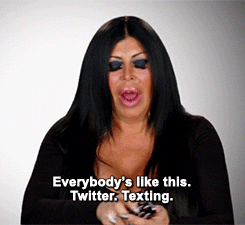
We live in a world where social media is king and has drastically changed the media landscape. Previously we only had one source of news and one way of helping during things like natural disasters.
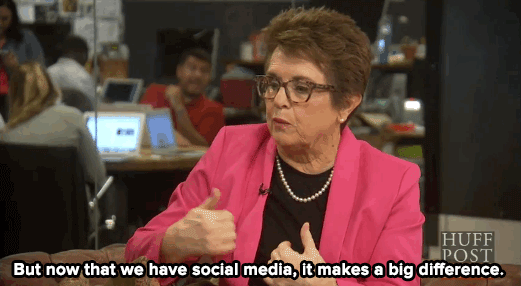
For at least 10 years Social Media has played an integral part in the way of news dissemination; if we take a look back to 2010 we look at the Haiti Earthquakes, Gao, Barbier and Goolsby (2011) mentioned that after the Earthquakes in Haiti there were numerous amounts of posts, photos and videos about their own experiences during the earthquake via various social media sites like Twitter, Facebook, Flickr, YouTube and blogs With this massive social media coverage, everywhere you went on the internet you would see ads, videos, posts urging you to donate and this is seen, as is mentioned by Morgan (2010), through the $35M that was received by the Red Cross within 48 hours, and $8M through their text service, setting a world record for amount received for a mobile campaign.
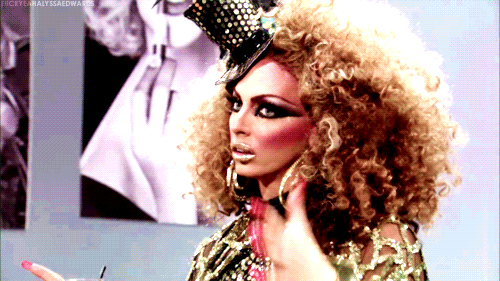
So we see that the use of Social Media is inherently a good thing, of course, there is a way for the coverage of natural disasters on social media can lead to slacktivism there is a definite upside to this coverage. Looking at one of the readings for this week “The Twitterisation of ABC’s Emergency and Disaster Communication” there were many questions asked of the ABC and the way they handled the 2011 Queensland Floods, as the article states, the ABC’s twitter account was the 2nd most visible presence on twitter about the floods. The ABC did mention that although there were many challenges in running so many social media accounts it did find that with every new disaster the staff become more and more confident in how to use social media.
They also did state that they established a new twitter handle that is solely used for emergencies. Looking at this twitter it is still active and it is used for natural disasters like floods and cyclones but it also looks at weather emergencies. This is something that ABC has done quite well and in the future, they do know what they are doing. ABC understand that social media is an integral, and a big part of the puzzle in navigating a “post-disaster” landscape.
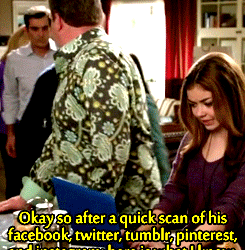
Social Media is a large part of crowdsourcing as seen in the Haiti example and to ignore social media is downright ignorant. Looking at other social media sites like Facebook, they have picked up on this and, in 2014, implemented a safety check in response to all the disasters and crises that were happening. This sort of device really again cements the fact that the most important means of crowdsourcing and disaster news dissemination comes from social media. References Gao, H, Barbier, G & Goolsby, R 2011, ‘Harnessing the Crowdsourcing Power of Social Media for Disaster Relief’, IEEE Intelligent Systems, vol. 26, no. 3, pp. 10-14. Lo ,P, & Possetti, J 2012, ‘The Twitterisation of ABC’s Emergency and Disaster Communication’, Australian Journal of Emergency Management, Vol.27(1), p.34-39 Morgan, J 2010, ‘Twitter and Facebook users respond to Haiti crisis’, BBC News, 15 January, viewed 28 April 2017, <http://news.bbc.co.uk/2/hi/americas/8460791.stm>.
4 notes
·
View notes
Text
Crowdsourcing in Times of Crisis
Howdy partners! The Goat is back. Today we’re going to look at the concept of crowdsourcing and it’s application in times of crisis. But before we get too far down the track, let’s first align on what crowdsourcing is. A great definition I came across is this:
“Crowdsourcing is the practice of obtaining information or input into a task or project by enlisting the services of a large number of people, either paid or unpaid, typically via the Internet” (Oxford Dictionaries | English, 2017)
Whilst the modern definition of crowdsourcing is very much linked to the internet, the actual practice of sourcing ideas and input from large groups of people is intrinsically linked to the concept of democracy, which dates back over 2,500 years to ancient Greece, and has evolved to remain relevant in modern times (Dunn, 1995).
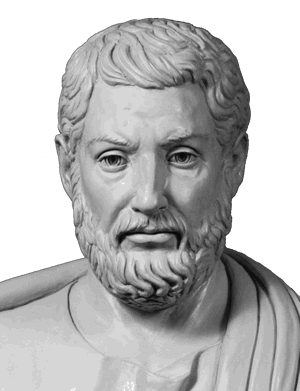
Above: Cleisthenes (born c. 570) was an Athenian noble who is widely credited as the founder of democracy (Dowling, 2016)
So as we can see, crowdsourcing requires listening to the views of other people. Modern technology has arguably made it easier to listen to the views of more people than at any other time in human history. This is incredibly important for a variety of reasons, not least of which relates to the coordination of emergency resources in response to disasters. In Australia, bushfires and floods are an ongoing challenge for both the public and emergency services. The use of digital technology and real-time input from people live on the scene (residents, witnesses) is becoming increasingly vital in disaster response, as traditional methods of communication such as call centre hotlines struggle to cope with influxes of information. Ping Lo, the ABC’s social media coordinator, made the point that, “when an emergency happens here, the phone lines of stations are in meltdown with members of the public wanting either to contribute or to request information or assistance” (Posetti & Lo, 2012, Q5). Digital platforms such as Twitter and Facebook make it much easier to communicate with internet connected audiences in a timely manner. See the ABC Emergency example below (Australian Broadcasting Corporation, 2017)
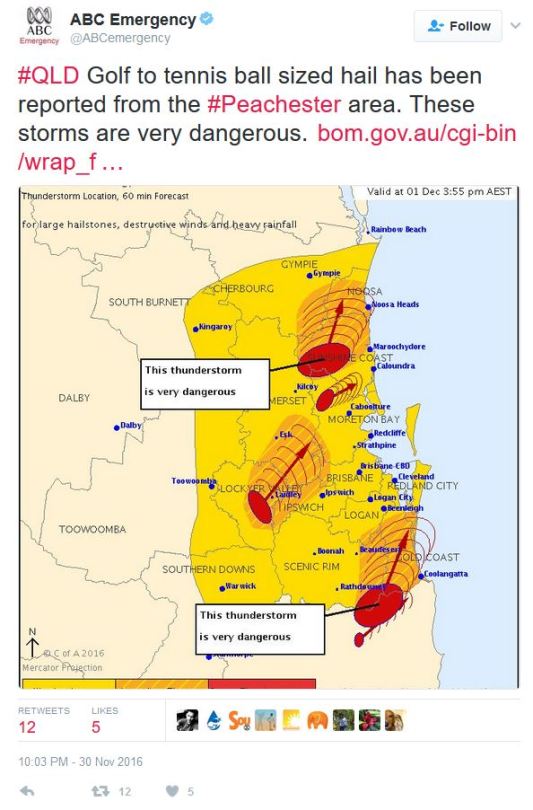
In addition to spreading warnings and providing updates on disasters, emergency services are also starting to use crowdsourcing as a means of gathering information for arrests and conviction. See the Victoria Police example below (Victoria Police, 2017)
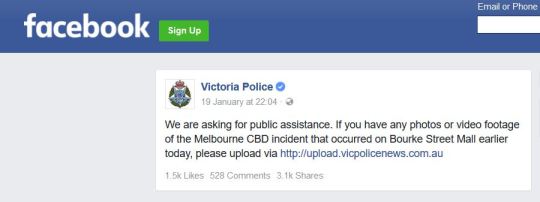
Clearly crowdsourcing is a valuable asset to emergency services, and more money and research will likely contribute to the improvement of current systems. A report conducted on the Queensland floods of 2011 observes that, “crowdsourcing information through social media may play an important role in this process, and appropriate technological supports for these activities...should be trialled” (Bruns et al, 2012).
Despite the advantages of crowdsourcing for information, there is still a requirement to vet the information for accuracy. Both ABC Emergency and Victoria Police only retweet information from reliable sources (Bureau of Meteorology, other emergency services) thus mitigating the release of false or misleading information which could be confusing and potentially fatal in an emergency scenerio. The threat of trolling and hacking have the potential to waste time and resource and as such, much of the crowdsourcing currently used in relation to disasters is in the background, out of sight of the public.
Goat out.
References
Australian Broadcasting Corporation, (2017). ABC Emergency tweet on hail. [image] Available at: https://twitter.com/ABCemergency/status/804204263555481600 [Accessed 5 Feb. 2017].
Bruns, A, Burgess, J, Crawford, K & Shaw, F 2012, #qldfloods and @QPSMedia: Crisis Communication on Twitter in the 2011 South East Queensland Floods, Arc Centre of Excellence for Creative Industries and Innovation, pp. 7-10, viewed 3 August 2016, <http://www.cci.edu.au/floodsreport.pdf>
Dowling, M. (2016). Bust of Cleisthenes. [image] Available at: http://www.mrdowling.com/701-athens.html [Accessed 5 Feb. 2017].
Dunn, J. (1995). Democracy. 1st ed. New York: Oxford University Press.
Oxford Dictionaries | English. (2017). crowdsource - definition of crowdsource in English | Oxford Dictionaries. [online] Available at: https://en.oxforddictionaries.com/definition/crowdsource [Accessed 5 Feb. 2017].
Postetti, J & Lo, P 2012, The Twitterisation of ABCs Emergency & Disaster Communication, Australian Journal of Emergency Management, Vol. 27, no. 1, pp. 34-39.
Victoria Police, (2017). Request for help from public regarding Bourke St Mall incident. [image] Available at: https://en-gb.facebook.com/victoriapolice/posts/1395747033830762 [Accessed 5 Feb. 2017].
1 note
·
View note
Text
We DO have the power!... through crowdsourcing!
2 heads are better than 1… aren’t they?
I grew up with this ol’ adage as a child. If I was ever struggling with an idea or pulling something together, I reached out to family and friends to help me to understand it and to ultimately solve my problem. It seemed to work every time.
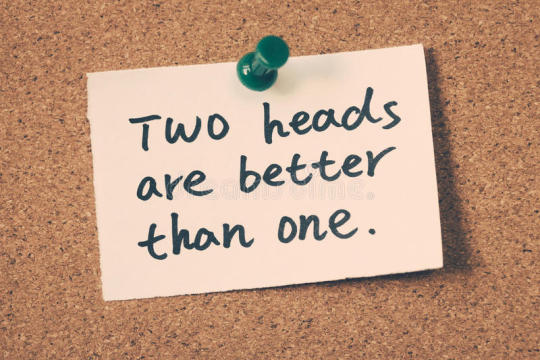
Imagine what you could do with the collaborative power of connecting large groups of people to solve problems. Mind-blowing!
So how do we do this?
Through the use of the internet of course! And it even has a name! Crowdsourcing
So let’s look at Crowdsourcing in its basic form, then we’ll delve a little deeper and see how it could be applied through Social Media to help people in times of crisis.
So what in a nutshell, what is Crowdsourcing.
According to Crowdsourcing.org, Crowdsourcing can be loosely defined as connecting large groups of people using the internet. This can be utilised for many different purposes, in particular, to connect knowledge, expertise and resources which produce results in shorter time periods than if attempted alone (Crowdsourcing.org, 2012).
youtube
Furthermore, Crowdsourcing.org discusses the affordance that the internet can provide to solve problems, by simply connecting people quickly together in a guided fashion that you wouldn’t know without the internet (Crowdsourcing, 2012). Pretty cool eh?
So who can use Crowdsourcing? Pretty much anyone Crowdsourcing.org states, can utilise the benefits of Crowdsourcing - companies, individuals, groups and governments. So how does it work?
1. Access an online workforce, then simply select and identify workers 2. Ask the crowd questions to help you solve the problem at hand 3. Information pertaining to your problem may already be there, but you need help to find it 4. Seek ideas and feedback from the crowd to help you solve your problem
Does the connectivity of the internet make the possibilities endless?
What if we add another layer.... and add the power of social media!
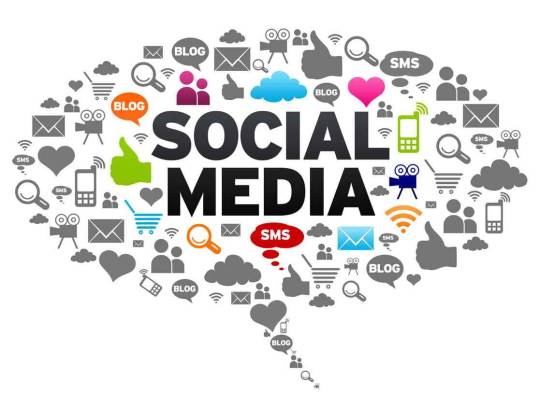
What Social Media platforms have you used to get updates in times of crisis?
Is Twitter the most effective? searching using #hashtags?
Is Facebook your favourite go to?
I’d have to say, I fall into the Facebook category, not having a Twitter account, and not knowing the power of # I readily use Facebook to keep up to date with burn offs, check local board pages about updates of helicopters etc. I also strongly believe now that I’ve moved to a technically “rural” area more recently, I am more keenly aware of issues surrounding bushfires etc, as they will have a greater impact on my family now, rather than before - living in suburbia.
So how is Social Media changing the way emergency services and the government communicate with us, the public, in times of crisis?
Julie Posetti and Ping Lo discuss the significant shift in the use of Social Media and Crisis Management in their report about the Queensland Floods in 2011. They discerned that the Queensland Police Media Twitter feed was the most viewed resource for keeping the public informed about changes in the situation. The report details the importance of funnelling many sources into the one feed, to create a “source of truth”? for the viewer, however to do so, came with challenges as discussed by Posetti and Lo which included coordination of many sources into the one feed, being pulled from all over the state, while still being true to serving their public on traditional media platforms, as well as the untested use of the platform Ushahidi (a platform developed to bring together the compelling location-based information from people on the ground utilising SMS, tweet, online form and email).
The key benefits of utilising a platform like Ushahidi allows any member of the public the opportunity to offer information which is collected and mapped, which would reduce the impact on the physical resources of the police stations that are bombarded with telephone queries almost to the point of meltdown.
Are there any drawbacks?
Yes.. Not everyone is honest, are they? Not even in times of crisis can we totally rely on everyone doing the right thing, this is particularly apparent and discussed in Heather Ford’s article where she discusses similar challenges (Ford, 2012), as well as the report developed by Posetti and Lo, that not all information is verifiable at the time of submission, which in extreme conditions, can be the difference between life and death (Posetti & Lo). However, it is determined that Ushahidi has the potential to make sense of this 'noise' but it almost requires a disclaimer to state that “it’s not perfect”.
So what’s the bottom line...
In a time of crisis, I personally would like to think that most of the information is verifiable, but with a degree of uncertainty. Additionally, I would be grateful for being able to view “almost real-time” data about a situation that may threaten my family, as opposed to sitting back in front of the TV hoping that there’ll be coverage of my area. I take the risks front on and accept that they may not be 100% right, but hope that in time of crisis, that our Emergency Services and Government pull together to utilise something like Ushahidi to keep us informed.
What're your thoughts?
References:
‘561′, [image] viewed 6 May 2018 <https://i2.wp.com/www.qudsn.co/wp-content/uploads/2017/03/561.jpg?fit=1117%2C816&ssl=1/561>
‘two-heads-better-than-one-note-bulletin’, [image] viewed 6 May 2018 <https://thumbs.dreamstime.com/b/two-heads-better-than-one-note-bulletin-board-65145123.jpg>
Crowdsourcing.org 2012, Crowdsourcing and Crowdfunding Explained, 15 March, viewed 6 May 2018, <https://www.youtube.com/watch?v=-38uPkyH9vI>
Ford, H 2012, Crowd Wisdom [online], 30 November viewed 7 May 2018 <http://journals.sagepub.com/doi/abs/10.1177/0306422012465800>
Posetti, Julie and Lo, Ping. The Twitterisation of ABC's emergency and disaster communication [online]. Australian Journal of Emergency Management, The, Vol. 27, No. 1, 2012: 34-39.
0 notes
Text
#5 Hello this is Twitter, what is your emergency?
With social media being a very big part of most people’s lives, it’s only natural that it is now used a resource in emergency situations as well as every day life. With the fact that social media is so easily updatable in real-time and that many people use it frequently throughout the day or at least have notifications on to see when there has been new activity, it is no surprise that using social media as a tool during emergencies has proven to be very effective. By using social media as the point of information in emergencies, the public is using a form of crowdsourcing - ‘the practice of obtaining needed services, ideas, or content by soliciting contributions from a large group of people and especially from the online community rather than from traditional employees or suppliers’ (Merriam-Webster dictionary).

Personally, I have notifications on from the ABC, so they will message me when there is breaking news or an emergency situation, but often I will hear about a crisis from friends on social media before I hear about it on mainstream media. For example, when I was living in Hobart, during the 2013 Tasmanian bushfires I found out about the fires from my friends posting on social media before the news was covering the emergency.
However social media was later utilised in this situation when a local resident, Melanie Irons, started the Facebook page Tassie Fires - We Can Help this was where updates about the fires were posted by residents and where people could post about services or resources they could offer those in need and where others could post about what they needed.
Although this was very useful resource, there was no way to know if the information being sent in was true and verified, which is why some still choose to rely on traditional media forms. However, some traditional media organisations have begun to utilise social media in emergency situations. For example, during the 2011 bushfires the ABC utilised their social media presence well, however in The Twitterisation of ABC’s Emergency and Disaster Communication, social media researcher Julie Posetti discusses the ABC’s continuing preference with using traditional media such as radio, for their main source of emergency information. The report on the effectiveness of social media during the Queensland floods, Crisis Communication on Twitter in the 2011 South East Queensland Floods, stated that ‘Media organisations (especially the ABC, as the national emergency broadcaster) play an important role in crisis communication, and need to connect closely with emergency services during natural disasters. Retweeting emergency messages may be appropriate.’ Indicating that the ABC’s role in sending out emergency information during the Queensland floods was important and needs to be ongoing throughout other crises.
The report also states that ‘Coordination between different emergency and government services, and with media organisations, is important to avoid conflicting messages and ensure that key information is widely disseminated. Dissemination of corrections and end-of-alert announcements should be improved.’ This shows that the relationship between crowdsourced information and verified sources is important during an emergency. Both play an important role and when working together they can strike a balance that can save countless lives.
0 notes
Text
#Mobilise : Crowd Sourcing in Times of Crisis [Week 8]
A simple form of assigning tractable metadata to a word or phrase now has the potential for crowd sourcing in times of crisis. Since their introduction, hash tags have revolutionised how we search for and share social media content and perhaps most importantly, how news breaks online. Hash symbols were originally used in the 1980s to label groups and topics on Internet Relay Chat, a pre-social media communication network. Almost two decades later in August 2007, hash tags were introduced on Twitter to assist users in accessing and filtering relevant content in their feeds. However it was not until the California wildfires in 2007 that hash tags were finally utilised to organise and share relevant information about an unfolding event. Two years later, Twitter introduced hash tags as an official search tool and ‘Trending Topics’ feature, so that Twitter users could identify which topics were the most current at any given time or location (Lips, A 2018, p.1). Hash tags are now one of the most powerful tools to mobilise and networked publics during times of crisis or natural disaster.
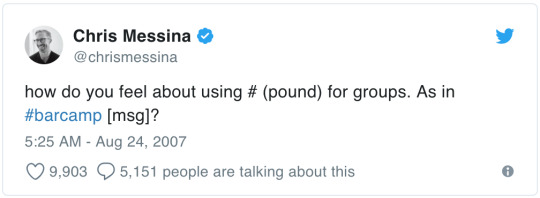
A key example of this would be the #QLDFlood hash tag of 2011. In mid-January 2011, the south-east region of Queensland was hit hard by unprecedented high flooding, isolating communities and wreaking extensive damage to both regional and built up areas. In response, “the Twitter hash tag ‘#qldfloods became the central coordinating mechanism for floods-related user activity” (Bruns, A, Burgess J, Crawford, K, Shaw, F 2012, p.7). As the situation unfolded, Twitter played a crucial role in amplifying the informational updates provided by emergency services and news broadcasters. According to an analysis report conducted in 2012, tweets marked by ‘#qldfloods’, “mostly managed to stay on topic and focussed predominantly on sharing directly relevant situational information, advice, news media and multimedia reports” (Bruns, A, Burgess J, Crawford, K, Shaw, F 2012, p.8). The Queensland Police Service Media account was amongst the most prominent and effective sources of information, correcting misinformation and responding directly to other users. The nature of Twitter and its encouragement of re-tweeting, has generated a new form of crowd sourcing, in that it can directly utilise the social media behaviour of an online public network to amplify a message via relevant hash tags.

However, utilising a public social media platform to publish emergency broadcasts comes with the risk of misinformation and misinterpretation. The ABC play a crucial role in emergency broadcast situations and continued to do so during the 2011 Queensland floods. To combat the risks involved in using social media during current events, the ABC focuses on message verification, which involves, “involving emergency sources in order to verify data, being clear about verified/unverified content when providing data, providing clear time stamps on submitted data and highlighting most recent updates and making the crowdsourcing process as transparent as possible”(Posetti, J 2012, p.38). For example, to combat misinformation during the flood crisis, the official Queensland police Twitter account made a ‘Myth buster’ hash tag to great succuss in disproving rumours and other misinformation (Bruns, A, Burgess J, Crawford, K, Shaw, F 2012, p.8).
Utilising social media as an emergency news broadcaster is still a relatively new phenomenon, however examples such as the Queensland floods in 2011 can provide a positive outlook for its future use. Even as I was writing this blog post, I noticed that the sky outside had darkened and a large amount of what looked like fog had descended. Out of interest, I typed ‘smoke haze Melbourne’ into Twitter’s search bar and the results showed a combination of both news broadcasters and residents explaining the smoke haze was due to scheduled burn offs of regional forestation areas. Crowd sourcing news and relevant information on Twitter via hash tags is undoubtedly integral to the future of digital citizenship.
References:
Bruns, A, Burgess J, Crawford, K, Shaw, F, #qldfloods and @OPSMedia: Crisis Communcation on Twitter in the 2011 South East Queensland Floods, Brisbane: ARC Centre of Excellence for Creative Industries and Innovation, 2012.
Lips, A 2018, History of Hashtags: How a Symbol Changed the Way We Search & Share, viewed 29th April 2018, https://socialmediaweek.org/blog/2018/02/history-hashtags-symbol-changed-way-search-share/
Posseti, J 2012, ‘The Twitterisation of ABC’s Emergency and Disaster Communication’, The Australian Journal of Emergency Management, vol. 27, no.1, pp.34-39.
0 notes
Text
#5 CROWD SOURCING IN TIMES OF CRISIS
At some point in our social media lives, I am sure we’ve all come across a post that has someone asking for money. Sometimes it’s a friend trying to cover the cost of medical bills, and other times it could be an organization raiding money for a national crisis. It then usually tends to lead you to a GoFundMe page, with their hopes of individuals contributing to crowdfunding their cause, no matter what their reason is.
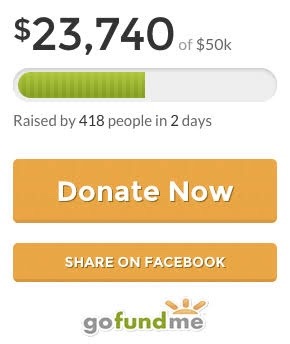
Crowd sourcing has become to be an important factor in times of crisis and has been made easier with social media and the tools that are available through an online presence. The standard community-level communication channels, that are around already have to purpose and ability to distribute information during a time of crisis, and with the use of social media the channels are able to be adapted to a new form and continue to distribute information in times of crisis.
The term crowdsourcing was coined by Jeff Howe, a politician from Minnesota. He defined it as “the act of taking a job traditionally performed by a designated agent and outsourcing it to an undefined, generally large group of people in the form of an open call” (Posetti 2012, p. 36).
The 2011 Queensland floods, was a key example of social platforms – Facebook and Twitter – playing an important role in this crisis and was also one of our main topics of this week’s lecture. The hashtag #qldfloods was used in over 35,000 tweets, that were sent during the disaster, and very quickly became an easy way for users to find information and used to “share breaking news of the latest event” (Liddy 2013, p. 1).
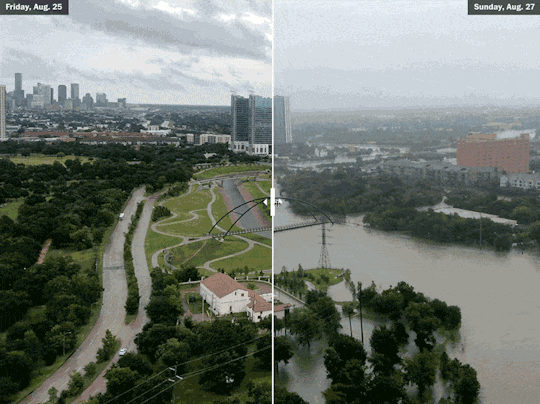
Twitter became a source for mainstream media both within Australia and overseas. Social media users around the world were sharing flood-related media resources. Whilst those close to the disaster were sharing their own experiences, as well as information and discussing the topic amongst other users (Liddy 2013, p. 1).
And now with how powerful social media has become – in particular Twitter – events can be organized more quickly, and with these events users are able to “find other who share their views and work together in disparate location to produce powerful sources of information” (Ford 2012, p. 33).
An example of this is the Manchester bombing, but more so the One Love Manchester, the benefit concert that saw Ariana Grande accompanied by Miley Cyrus, Katy Perry, Coldplay, Niall Horan and many more others come together to help raise money for the We Love Manchester Emergency Fund, which was established after the concert two weeks prior. The benefit concert raised more than 10 million pounds for the Emergency Fun, as throughout the performances, there were instructions on how to donate.
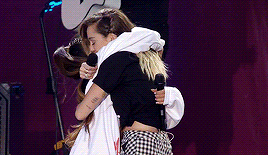
Both examples are important to show social media’s role in the crisis communication and emergency management. With these events still having similar ones happening to this day, it is important for regulatory bodies and emergency services teams have strategies that use both traditional and new communication technologies. With this it will help them to stay on top of what is happening during the times of crisis and pass on information that could save lives.
References:
Ford, H. (2012) ‘Crowd Wisdom’, Index on Censorship, pp 33-39
Posetti, J. & Lo, P. (2012) 'The Twitterisation of ABCs Emergency & Disaster Communication'
Gritt, E 2017, ‘Ariana Grande: ‘we had a totally different show planned’, News.com.au, 5th June 2017, pg1
Liddy, M 2013, ‘How Twitter covered the Queensland floods’, ABC News, 26th April 2013, pg. 1.
0 notes
Text
Week 8: Twitter for Survival
Back in the good old days before the mediatisation of society, emergency situations were communicated through the traditional media outlets: radio, television, and phone calls. But what if the phone lines were down? What if the power was out? What if no one had access to a radio in the emergency situation?
This is yet another benefit of social media networks. It is a quick and efficient way to make sure everyone has important, and at times life-saving, information, and this is partly due to social networks. People often develop social networks with people in their own community, to keep up-to-date on current events happening in their home towns. This means that if one person from that social network sees news of an emergency situation in their town, they can immediately alert their social network and the information will spread like wildfire.
Even the ABC has converted, though not entirely, to communicating emergency information through social media. Social media researcher, Julie Posetti, interviewed the ABC’s national social media co-ordinator in a paper called “The Twitterisation of ABC’s Emergency and Disaster Communication’”. In this interview, the ABC’s social media co-ordinator stated that, following the social media use in the Black Saturday bushfires in 2008, “employing well-organised social media could have a profound impact in an emergency situation”. While social media isn’t the only platform the ABC communicates disaster information through, it makes a huge impact on reaching the younger demographic who wouldn’t think to turn on their radio in times of an emergency.
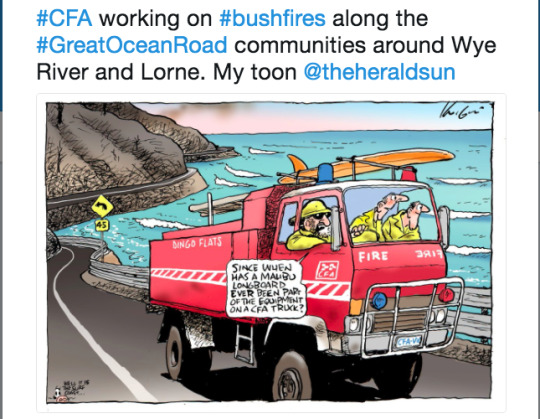
https://twitter.com/knightcartoons/status/681426534901526528
If I, as a 19-year-old who has grown up in the era of social media, was in an emergency situation like a bushfire, I would immediately turn to social media for a solution. If it weren’t for one Christmas day driving down to Portland during the Great Ocean Road bushfires of 2015, I wouldn’t know to turn to ABC radio to receive constant updates on the situation. My mum and I heard word that there were bushfires before we left, but that they weren’t supposed to be close to the road we had to drive on. Regardless, as soon as we hopped in the car, Mum turned the radio to ABC and we listened to the updates for the 4-hour drive.
The radio, in this case, was essential for staying aware on the progress of the bushfires, as our mobile phones didn't have reception for most of the drive. It is because of this factor that the ABC and other emergency broadcasters can’t get rid of traditional media outlets. But if I hadn’t been in the car that Christmas Day with my mum, I wouldn’t have known where to get my information.
I suppose that can be considered an example of my generation’s ignorance, but I prefer to think of it as the way we grew up. We’ve never had to turn to radio or free-to-air TV; we have grown up in the era of Facebook and phones, of Netflix and internet wherever we go. We are the social media generation, and I think it is important that we can still get emergency information through channels we would immediately think to use.
REFERENCES:
Posetti, J 2012, ‘The Twitterisation of ABC’s Emergency and Disaster Communication’, The Australian Journal of Emergency Management, vol. 27, no. 1, pp. 34-39.
0 notes
Text
Blog #5 Crowd Sourcing in Times of Crisis - The Twitterisation of Disasters
When a natural disaster occurs, depending on where it happens, we hear about it through our various media outlets. One of the first means of reaching a wide audience is through social media.
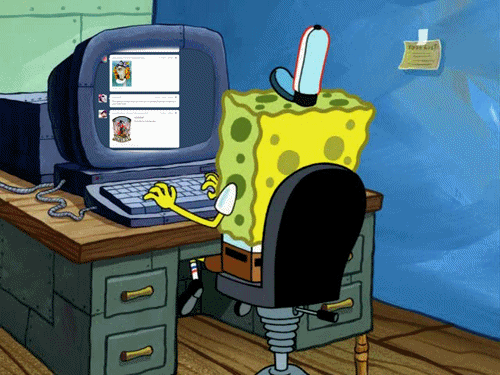
We live in a world where social media is king and has drastically changed the media landscape. Previously we only had one source of news and one way of helping during things like natural disasters.
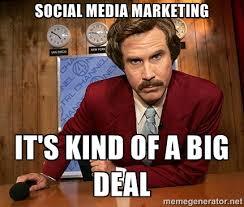
source: https://profitparrot.com/the-best-memes-about-social-media-for-2016
For at least 10 years Social Media has played an integral part in the way of news dissemination; if we take a look back to 2010 we look at the Haiti Earthquakes, Gao, Barbier and Goolsby (2011) mentioned that after the Earthquakes in Haiti there were numerous amounts of posts, photos and videos about their own experiences during the earthquake via various social media sites like Twitter, Facebook, Flickr, YouTube and blogs
With this massive social media coverage, everywhere you went on the internet you would see ads, videos, posts urging you to donate and this is seen, as is mentioned by Morgan (2010), through the $35M that was received by the Red Cross within 48 hours, and $8M through their text service, setting a world record for amount received for a mobile campaign.

source: https://tenor.com/view/ouat-seriously-onceuponatime-gif-4705897
So we see that the use of Social Media is inherently a good thing, of course, there is a way for the coverage of natural disasters on social media can lead to slacktivism there is a definite upside to this coverage.
Looking at one of the readings for this week “The Twitterisation of ABC’s Emergency and Disaster Communication” there were many questions asked of the ABC and the way they handled the 2011 Queensland Floods, as the article states, the ABC’s twitter account was the 2nd most visible presence on Twitter about the floods.
The ABC did mention that although there were many challenges in running so many social media accounts it did find that with every new disaster the staffs become more and more confident in how to use social media.
They also did state that they established a new Twitter handle that is solely used for emergencies. Looking at this twitter it is still active and it is used for natural disasters like floods and cyclones but it also looks at weather emergencies. This is something that ABC has done quite well and in the future, they do know what they are doing. ABC understand that social media is an integral, and a big part of the puzzle in navigating a “post-disaster” landscape.
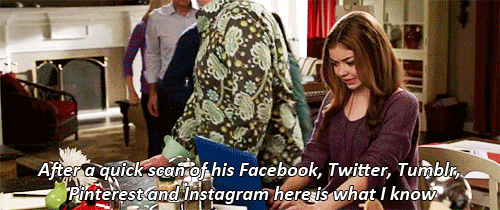
source: https://www.buzzfeed.com/avhunter/can-we-guess-how-many-facebook-friends-you-have-1kbea?utm_term=.lnZw0vwe2#.gwepkNpa6
Social Media is a large part of crowdsourcing as seen in the Haiti example and to ignore social media is downright ignorant. Looking at other social media sites like Facebook, they have picked up on this and, in 2014, implemented a safety check in response to all the disasters and crises that were happening. This sort of device really again cements the fact that the most important means of crowdsourcing and disaster news dissemination comes from social media.
Sources cited:
Gao, H, Barbier, G & Goolsby, R 2011, ‘Harnessing the Crowdsourcing Power of Social Media for Disaster Relief’, IEEE Intelligent Systems, vol. 26, no. 3, pp. 10-14.
Lo ,P, & Possetti, J 2012, ‘The Twitterisation of ABC’s Emergency and Disaster Communication’, Australian Journal of Emergency Management, Vol.27(1), p.34-39
Morgan, J 2010, ‘Twitter and Facebook users respond to Haiti crisis’, BBC News, 15 January, viewed 28 April 2017, <http://news.bbc.co.uk/2/hi/americas/8460791.stm>.
0 notes
Text
Week 9: Crisis and Social Media Inc.
Through the prevalent use of the internet and social media there are claims that we are always connected, always switched on. These statements can be attributed with negative connotations, but why can’t this connectedness help people access and contribute to information on new and open channels in times of crisis?
Ushahidi is an inspiring example of how terrible circumstances can bring like minded people together in the creation of a useful and innovative tool. Ushahidi, a crowdsourcing tool established to give “ordinary citizens the opportunity to report human rights abuses in the wake of the Kenyan presidential elections” (Ford 2012 p. 33). Since its inception Ushahidi has become an acclaimed success, but it has been hard to match the initial effect that it had since Kenya in 2007. Issues surrounding the verification of the information being passed to organisers has meant often relying on typical sources of information and media, going against its purpose. As well as issues involving distrust of the tool and media/information outlets in general.
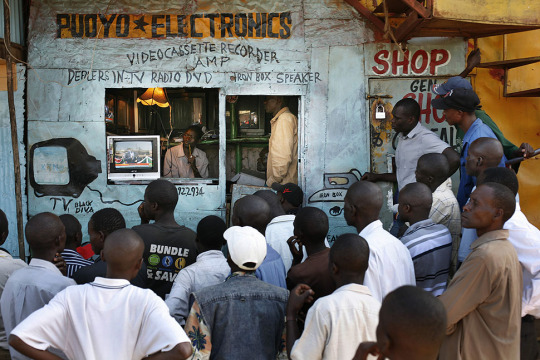
An example of how social media has impacted information sharing in times of crisis closer to home is the data collected following the 2010-2011 Queensland floods. The floods had huge and disastrous effects on the QLD population and infrastructure as well as 35 deaths (Creighton 2016). Following the floods a 2012 report concluded that second to traditional forms of news, information and media, Facebook was a strong information source. “Facebook was a platform for a range of media, information and interpersonal communication, and as the high number of Facebook links posted in tweets demonstrates, it is not separate from but integrated into the overall media ecology” (Bruns et al. 2012, p. 34). Becoming a leading channel for communication from emergency services.
During this emergency situation the ABC was able to incorporate varying forms of traditional media as well as new forms such as social media and even had a Ushahidi account set up. “It became evident to the broader organisation that employing well-organised social media could have a profound impact in an emergency situation” (Postetti & Lo 2012 p. 34). This was the first time that social media has been incorporated in information sharing with the public on such a large scale in Australia.
youtube
Although traditional forms of information dissemination such as radio are still vital to the disbursement of information, it is becoming clear that social media and input and information provided by the general public is playing an increasing role in the gathering and sharing of information duration times of crisis.
References:
Bruns, A, Burgess, J, Crawford, K & Shaw, F 2012, #qldfloods and @QPSMedia: Crisis Communication on Twitter in the 2011 South East Queensland Floods, Arc Centre of Excellence for Creative Industries and Innovation, viewed 3 August 2016, <http://www.cci.edu.au/floodsreport.pdf>.
Creighton, D 2016, 'Queensland floods 2011: The floods by the numbers’, Brisbane Times, 13 January, viewed 1 February 2017, <http://www.brisbanetimes.com.au/queensland/queensland-floods-2011-the-floods-by-the-numbers-20160112-gm4czk.html>.
Ford, H 2012, 'Crowd Wisdom', Index on Censorship, vol. 41, no. 4.
Postetti, J & Lo, P 2012, The Twitterisation of ABCs Emergency & Disaster Communication, Australian Journal of Emergency Management, Vol. 27, no. 1.
Image References:
ABC News (Australia) 2011, Social media helps communication during Qld floods, 19 January, viewed 1 February 2017, <https://youtu.be/uNAPKmkPaOQ>.
0 notes
Text
Crowdsourcing in good times and bad
“how do we incentivise a global assembly of brilliant minds to dismantle the malignant culture of secrecy?” (Nielsen 2011)

‘Crowdsourcing is the practice of obtaining services, ideas and content via contributions from a large group of online individuals and groups’ (Merriam Webster Online 2014).
Social media platforms such as Facebook and Twitter can be swiftly employed during times of crisis, to inform and enhance communication and response potential. Large swathes of valuable information can be collated into mapping services like Ushahidi, however the authenticity of user generated content can not always be verified at short notice Ford (2012, pp 35-39).
Emergency information, traditionally distributed via TV or radio is increasingly disseminated via social media platforms. Ushahidi is a map-based crisis-crowdsourcing platform, relying on valuable location-based information and was tentatively deployed by the ABC during the Queensland floods Posetti & Lo (2012).
While the full potential of crowdsourcing is still in its infancy, the transformative possibilities for future applications are revolutionary. Iceland is turning to crowd-sourcing its constitution, allowing citizens to ‘remain constantly involved in shaping the rules that govern their society. In doing so they hope to redress the balance of power between citizens and government’ (Kinna, Prichard and Swann, 2016).
Further to the limitless possibilities of crowdsourcing, are movements within the scientific community to share research and expedite life-saving cures. ‘Scarce funding has created a competitive environment obsessed with the publication of peer reviewed papers’ (Nielsen, TED 2011).
Emphasis on publication incentivises scientists to hoard their work, while parallel laboratories skulk in the shadows, re-inventing the wheel instead of pooling their resources via the two principles of open-source science and crowdsourcing.
(Nielsen, TED 2011) recommends “Any publicly funded science should be open science,” however, without government intervention the solution may lie in the answer to the following question,
“how do we incentivise a global assembly of brilliant minds to dismantle the malignant culture of secrecy?” Is the incentive money? accolades?
Perhaps each disease could have its own crowdfunding page attached to an open-science forum. The charitable donations could be held as jackpot until a cure is found, then distributed on percentage basis amongst the contributing scientists.
Perhaps I need to crowdsource the answer. How would you incentivise an industry subjugated to whims of a self-interested benefactor?
The possibilities are endless, crowdsourcing is a utopian alternative to our current political shortcomings, it could be used to circumvent capitalist restraints, re-imagine socialism or simply ‘define social challenges and put them out to volunteer technologists to solve’ (Random Hacks of Kindness, 2014).
youtube
References
'crowdsourcing entry' 2014, Merriam Webster, viewed 3 August 2016,<http://www.merriam- webster.com/dictionary/crowdsourcing>.
Ford, H 2012, 'Crowd Wisdom', Index on Censorship, vol. 41, no. 4, pp. 33-39.
Kinna, R., Prichard, A. and Swann, T. 2016. Iceland's crowd-sourced constitution: hope for disillusioned voters everywhere. The Conversation, 28 October, viewed 12 Jan. 2017, http://theconversation.com/icelands-crowd-sourced-constitution-hope-for-disillusioned-voters-everywhere-67803
Postetti, J & Lo, P 2012, The Twitterisation of ABCs Emergency & Disaster Communication, Australian Journal of Emergency Management, Vol. 27, no. 1, pp. 34-39.
Random Hacks of Kindness 2014, viewed 12 January 2017, <http://www.rhok.org/>.
TEDx Talks, 2011, Open science: Michael Nielsen, 6 April, viewed 12 Jan. 2017, <https://www.youtube.com/watch?v=DnWocYKqvhw>
TEDx Talks, 2011, Open science: Jay Bradner, 27 October, viewed 12 Jan. 2017, < https://www.youtube.com/watch?v=wOiKRVH0nQ8 >
Ushahidi 2014, viewed 12 January 2017, <http://www.ushahidi.com/>.
Images
doodletilt.tv 2012, 'Crowdsourcing in government: Can it really work?' [image], Linking Asia 21, viewed 12 January 2017, < http://linkingasia21.net/2012/02/crowdsourcing-in-government-can-it-really-work/>.
Images
doodletilt.tv 2012, 'Crowdsourcing in government: Can it really work?' [image], Linking Asia 21, viewed 12 January 2017, < http://linkingasia21.net/2012/02/crowdsourcing-in-government-can-it-really-work/>.
0 notes